#27 ~ musings from along the camino de santiago
I recently returned from a magnificent adventure, walking roughly 220km, or 140 miles of the Camino Frances, the route of the Camino de Santiago that starts in St. Jean Pied de Port in France and stretches 500 miles to its end at the cathedral in Santiago de Compostela, in northwestern Spain. It started out as a ‘bucket list’ kind of thing and ended up a triumph of body, heart and spirit, a lovely journey of discovery, treading paths that ranged from smooth and straight, to those consisting of boulders and cobbles twisting up and over mountain ranges, and even some of the ancient Roman Road. It was exhilarating, sometimes brutal, exhausting and energizing all at once, and ultimately gave me a great sense of accomplishment and a new faith in this body that is heading me into my 63rd year in this life. It pissed me off sometimes, scared me sometimes, always exhausted me but mostly, delighted. Every dawn was like a snowflake, no two ever the same with new colors and sounds, and around every turn, a vista previously unseen or a tiny village hewn of stone and hard work yet unexplored, a mountain to be crossed and new people to meet. I jumped into this unknown with a traveling companion who was equally willing to meet each day’s new challenges, all of the adventures, the long and hard miles and uncertain moments with remarkable verve and cheer and the trust we held for one another got us through the journey with an even stronger bond than we started with. I’m sure my recount of our Camino will come in several installations here – I’m not known to be brief with words on the page, and there are so many photos I’d love to share with you that I’ll just take it in stages. And begin at the beginning.
** From Wikipedia – The Camino de Santiago (Latin: Peregrinatio Compostellana, Galician: Camiño de Santiago), also known by the English names Way of St. James, St. James’s Way, St. James’s Path, St. James’s Trail, Route of Santiago de Compostela,[1]and Road to Santiago,[2] is the name of any of the pilgrimage routes, known as pilgrim ways, to the shrine of the apostle St. James the Great in the Cathedral of Santiago de Compostela in Galicia in northwestern Spain, where tradition has it that the remains of the saint are buried. Many follow its routes as a form of spiritual path or retreat for their spiritual growth. **
My interest in the Camino de Santiago first came along in 2001 when I attempted to slog through Shirley MacLain’s book “The Camino – A Journey of Spirit”. It intrigued me for a while, the first 1/3 being a very visual and visceral account of her walk and her reasons for engaging in it … but then it deteriorated into personal drama and I just had to put it down. (I don’t recommend it.) It got some juices flowing. Then along came Emilio Estevez’s lovely film, The Way, starring his father Martin Sheen. I think that’s what tipped it for me. (I do recommend it!) The idea of trekking long cobbled and earthen paths through remote rural villages … the beauty, the silence and solitude as well as meeting people of like mind from all over the globe, it all resonated deeply within. Someday, perhaps.
That someday came when one of my 2014 Greek ‘Journey to the Muse’ travelers, writer Stephanie Hayes, told me early this year that she would like me to organize 3 weeks on the Camino Frances for her … if I would join her along the Way.
How could I pass that up?
There was a lot to do to prepare. With only 3 weeks total to travel and walk, I wanted to be sure that we picked a start point that would give us as much experience of the different regions of Northern Spain as possible. Airfares and anchor point hotels needed to be secured, and because we didn’t feel we wanted to follow the recommended ‘stages’ put forth in the guide books I mapped out an idea of rough start and stop points we might use as a template to avoid the crowds of peregrinos (‘peregrino/a’ means ‘pilgrim-someone who goes on a pilgrimage’.) that still, in autumn, flowed along like a river, most using the guide books as their bible. We each needed a properly fitting backpack, shoes worthy of a pretty tough 200km trek, to be sure we were fit enough to be able to make the journey with as few problems as possible and learn how to pack 10% -or less- of our bodyweight, only bare necessities because we would be carrying whatever it was we packed from start to finish. And we both needed to brush up our Spanish speaking skills. Once Steph and I agreed on our plan it wasn’t long before we were on our way. We set off for Madrid on the 25 September.
After a long slog on Norwegian Air (Cheap, and the transatlantic segment is taken aboard a new, dreamy ‘Dreamliner’ 787 aircraft that engages technology purportedly lessening the effects of jetlag. I testify! It really does help.) we arrived in Madrid – close to midnight, and when the taxi dropped us off, we thought a mistake had been made. Where was the hotel? Standing in a travelers haze on a dark, narrow street in old Madrid it looked as though we’d been abandoned at the entrance to a heroin den, or perhaps a whorehouse, with only a few signs overhead lit by bare bulbs – but nestled in amongst the few there was a small sign that spelled out, in cheap block letters, Hotel Astoria. Bingo. We hoped. Online photos certainly do glamorize the reality of some of these older, and cheaper, urban hotels! Down the dimly lit, green hallway was a barred door we had to be buzzed through, and once inside we promptly got lost in the bowels of a huge Escheresque maze of a building. Many of these grand old buildings housed more than one ‘hotel’, and here, ours was one of 3, a bit old and funky, a grand dame who had seen her day long ago but had since hit the skids, but what were we going to be doing there other than sleep?
We headed out early into the next day to explore and, surrounded by sounds of the waking city and the music of foreign language, we enjoyed our first café con leche and croissant at a busy corner café – stared blankly at a city map and up at the cacophony of morning traffic swirling around us, but shaking the jet lag from our heads, found our bearings and began our adventure.
Madrid is a marvelous city with a vital veneer. Orderly and modern while at the same time mirrored by the beautifully archaic and chaotic, it was welcoming, clean and surprising. I wondered where the more than 600 homeless of Madrid lived? The disenfranchised? The hungry children and the forgotten ones? Surely they were sequestered in other pasts of the city to not scare the tourists away. I didn’t even see any street animals. That felt oddly disconcerting to me, for what it really meant was that poisonings must occur regularly. Traveling to Greece each year, I appreciate Athens’ transparency. Perhaps because there is no way, there are no funds to hide the homeless, the addicts, the migrants, the refugees, the strays – what you see is real life. Nothing can be hidden. The graffiti on all of the walls screams out Greece’s pain. Here, even all of the graffiti we saw on foot and by bus was ‘clean’. It really is a lovely city to walk in and that we did, winding through narrow streets and exploring Puerta del Sol, a quaint and fun but horribly touristic part of the old city. Here, though, we found the ‘Orange’ store where I purchased a SIM card for my old, unlocked iPhone for 25 euro, offering enough data for 3 weeks and more on the Camino. For 25 euro? Really, priceless! Ha, take that, ATT!
On from there through a gorgeous park we headed to the beautiful Prado, the Spanish National art museum which mostly houses canvasses painted by the celebrated Spanish artists, all depicting the countries strong ties to the Catholic church and wars … lots of blood, butchery and decapitations, royalty and of course, Mary, Jesus, Saints and Angels. Not being a religious person, I missed the intended significance of the many paintings of a beautiful woman, holding an exposed breast in hand while shooting a stream of milk into the gaping mouth of some wretched, depraved or… penitent… man, always sitting at her feet. To me, this was gloriously symbolic of the Mother, Woman, her nourishment of earth and man, but what it meant to those of the Catholic faith, I haven’t a clue. We did, though, see Goya, El Greco, Hieronymus Bosch, Dürer, Raphael, Botticelli, and a few beautiful and absolutely incongruous Rembrandts and Rubens.
After a detour through the peace and shade of the National Gardens next to the Prado we walked some more – past the ‘Museo de Jamon’, The Museum of Ham. Really! – down to Plaza Mayor, the English plaza built during Phillip III’s reign (1595-1621), where we stopped for nourishment and people watching in an outdoor café, enjoyed living street art and the old, narrow streets, even found a glass of Malamatina retsina at a tiny Greek shop tucked in amidst the tapas bars.
Our last stop, back at our corner café for glasses of vino tinto to ensure sleep would come, propelled us back to our hotel – where we both collapsed in a delirium of jet lag and exhaustion tinged with an anticipation of what the coming days might hold for us. (Of course, the vino tinto helped! Tinto is a Spanish house red wine that rivals ANY high-mid level Cab or Merlot one can get in California. But it comes at the equivalent of $1.30 per glass instead of $8 – $15 per glass, and accompanies every afternoon or evening meal. In bars, it comes with what I call mezé, a wholly civilized offering of something to nibble on while one enjoys a glass.)
Early the next morning we took a bus to the northwestern city of León, where we would start our Camino. It was quite luxurious to sit back and watch the Spanish scenery float by from a comfy seat, and I was not only impressed by the numbers of wind turbines we saw set out in remote areas away from villages and farmlands, but even more so by the acres and acres of solar panels that were spread widely across the vista.
A very old city, Leon was founded as a military encampment around 29 BC, and is marked by cathedrals, basilicas and monasteries. Its old town is quaint, with veins of crooked, narrow streets and balconies on old buildings overflowing with colorful flowers. A bit too perfectly Disney-like for me, but I understand that tourism is one of the only viable industries left to this area, and to survive, the people must cater to tourists as well as to the volume of peregrinos traveling the Way to Santiago. We had an afternoon, during siesta, to explore and plied the streets from the massive Santa Maria de León Cathedral at one end, to Antoni Gaudí’s neogothic Casa de los Botines at the other, and ate dinner at a time quite normal for southern Europeans but unbeknownst yet to us, not for pilgrims, and then readied ourselves for the first day of walking.
Cafes in Spain are known as ‘bars’. And here is Mecca for the peregrinos! Café con leche, always a double espresso and steamed milk, even in the smallest of villages, and the morning fare of pastries or ‘tortilla de patatas’, a Spanish form of omelete made with eggs, potatoes and always whatever greens are fresh from the garden – occasionally a French omelete or fried eggs with regional ham – can be found in any bar and always would get the machine moving. We learned quickly, though it may not be our custom at home to eat a good meal at 6 AM, it is something we must do at some point in the morning along the Camino if we are to make it 9 to 15 miles walking up and down, on cobbles and boulders or earthen paths. One can also refill water bottles at the bars, and often nearby is a small market where one can buy snacks for refueling along the way. Bars are also one’s savior at the end of a long day, as they offer a ‘pilgrims’ meal’, which for the equivalent of $10 consists of 2 main courses (each course is your choice of one out of four homemade dishes, ranging from mixed salads – lettuce, hard boiled eggs, white asparagus, whatever veggies are fresh at the moment in the proprietors garden, and a large helping of tuna on top – to hearty soups, lentils, pasta dishes or fresh fried or grilled fish.), a DELICIOUS dessert, and a glass, or ½ bottle or sometimes a full bottle of ‘vino tinto’ or coffee. And always water. BUT – the end of the day’s long walk, assuming one starts around dawn, usually comes at mid afternoon and if one doesn’t take advantage of that time to eat the ‘big dinner’, you are out of luck until around 8 PM. During siesta everything closes up, except bars for coffee or drinks, from around 4 to 8. We quickly learned that 8 PM on the Camino is known as ‘Pilgrims Midnight’. Most of us, no matter level of fitness or how far we’ve walked, are soundly asleep at 8 PM! So … lessen learned the hard way. Eat BIG before 4 PM!
Before dawn and by city bus we headed to the suburban village of La Virgên del Camino, just on the outer edge of León, and started our walk by first light. Every stage of the Camino is marked, though sometimes a bit confusingly, by stone or cement pillars engraved with the symbol of the Camino, the scallop shell, and embellished with a yellow arrow pointing in the direction one needs to go. There are also yellow arrows painted on walls or the road to help one find the way in any confusing interim. We found our first arrow and off we went.
Our first day was blessed by bucolic landscape, with a distant horizon and few people walking. We were on the last of what is known as the Meseta, the sprawl of flat wheat and sunflower fields that takes several days to cross on foot, brutally hot by summers day and cold with a bitter wind in cooler months, but as we were starting at the Meseta’s end, the weather was mild and with the vast stretches of arid plane and the stubble of the summer’s wheat came interruptions of rolling hills, undulations of wilds, groves of pines and oaks. We walked together and chatted quite a bit that day – until we met the first hills. At 5’6, I take one stride to Stephanie’s two (she’s 5’2), so necessity decreed we find our individual rhythms, which meant sometimes we walked together, sometimes not. Once finding my own cadence, in the marriage of motion and breath I fell into a presence that comes with the awareness of that union … the stunning quiet, the cold of the morning, the warming sun, the whisper of wind and the chorus of birds as we walked through tiny villages and stone bridges from copse to copse, it all gave me my day in church by days end. This is my element.
The path was red earth and mostly even ground, and stretched out long and lean before us. We came upon only one small village, Oncina de las Valdoncina, that had an open bar or that even looked remotely inhabited other than by goats or sheep! Here we rested, aired out our hot feet and damp socks, and had a café and bocadillo, a very dry Spanish sandwich consisting only of 2 very thick hunks of bread with either a slab of local cheese, or cheese and jambon, Spanish ham, hiding in its middle. Very. Dry. But when one is hungry, one doesn’t complain – much – and we, being ravenous, were willing to consume anything!
We walked 9.6 miles that first day, a fairly easy start as we had few large hills to cover, ending up in Vilar de Mazarife which is a quietly interesting little village, a farming village surrounded by endless fields of corn and set upon river’s edge, a place that seemed to have been dropped smack in the middle of nowhere. The first thing we noticed after the sudden appearance of cornfields, obviously non-GMO for their lack of even height and spacing, was the town’s old church, adorned with huge storks nests balancing precariously on the tower’s belfry. Storks!! The storks had fledged their young months ago, but we learned that they often will return to reuse their last year’s nest, and will create nesting communities- hence the 2 and sometimes 3 nests perched atop each church! We’d heard about the huge flocks of White Storks in N. Spanish flatlands, symbols of goodness and deeply honored by each village that had its own belfry blessings. They are watched over carefully by the VI International White Stork Census, an organization finding that the storks have recently begun abandoning their yearly migrations from N. Europe, opting instead to stay behind in relative comfort to forage easy pickins in Spanish garbage dumps. There are now local stork feeding initiatives in place now to help wean the birds from feeding at dumps that are rapidly being replaced by incineration plants.
In Mazarife there was one small market and one bakery, both closed during siesta of course, and only 3 ‘albergues’, accommodations like hostels for pilgrims. They can be very austere or comfortable, sometimes offering a few private twin-bedded rooms, but we had agreed early on that we wouldn’t be staying in the typical albergue unless there was a room to be had. Neither of us relished the idea of walking all day and then spending our nights listening to snoring, wild sex, farting or the rustlings-in-general of up to 60 other people in a common area. Because of this we didn’t carry sleeping bags, necessary if one is going to be sleeping in an albergue, which offers a cot or a bed, but no bedding. Many have been known to also offer chinches, or bedbugs. Albergues have somewhere one can wash out the days’ clothes and often will offer a pilgrims meal for dinner and an early breakfast. Here, at Meson Tio Pepe, we found a warm, loving welcome and scored a tiny twin room with its own bathroom sporting a tiny bathtub that looked best for clothes-washing, but by god, I pretzeled myself into it to soak in blessed hot water!
I convinced Steph that, before pouring ourselves into bed, a bit of a walk would be a good way to keep our muscles loose. So here began our practice of walking in the late afternoons and evenings, to not only remind our bodies that we loved them but also to explore where in the world the Camino had deposited us at the end of each day – a great way to get a glimpse of village life as it livened up after siesta. We wandered into the ‘stork church’ with the hopes of lighting candles for departed loved ones, but the idea of inserting a few euro into a transparent plastic box filled with electric candles didn’t really feel very satisfying. A bit of disappointment sent us out the door. But we’d begun our journey, arrived at the end of our first day, and life was good.
As the dark descended, I sat on a step outside our albergue to contemplate what this Camino might be for me. I had no plans for it to be a pilgrimage, as it is for many peregrinos. Certainly it was not a religious pilgrimage, for I am not at all religious. I am not a big fan of hiking, and certainly am not one who loves to hike 9 to 15 miles, day after day. I didn’t know what it would ‘be’ for me, but I knew that it would reveal itself, perhaps sometime soon. Or maybe it already had, for really, aren’t most meanderings out in open air, surrounded by birdsong and beauty measured careful step by careful step and metered breath all a spiritual pilgrimage, of sorts?
Onward, to Astorga, Rabanal and El Acebo.
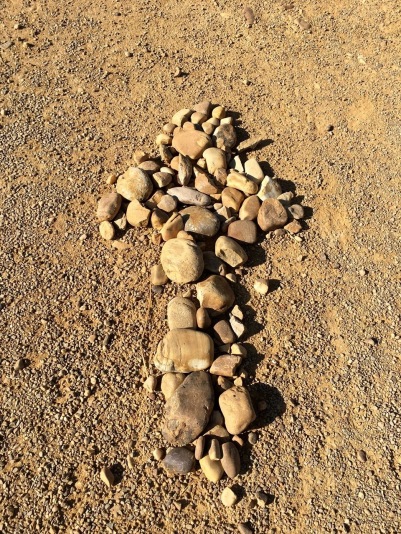
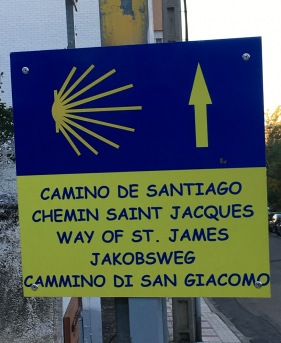
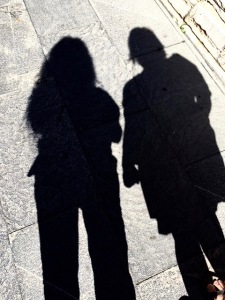
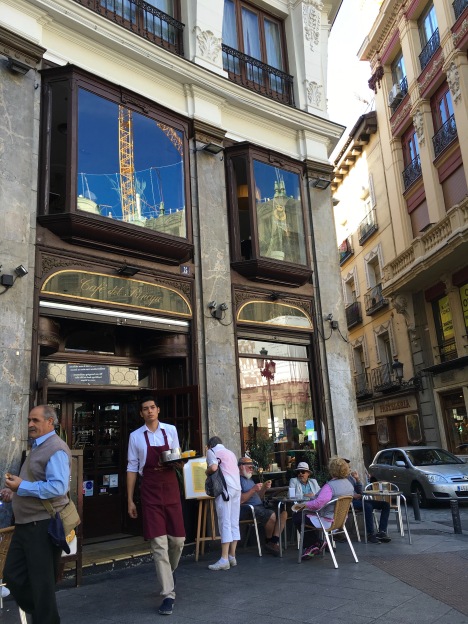

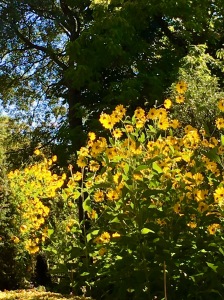
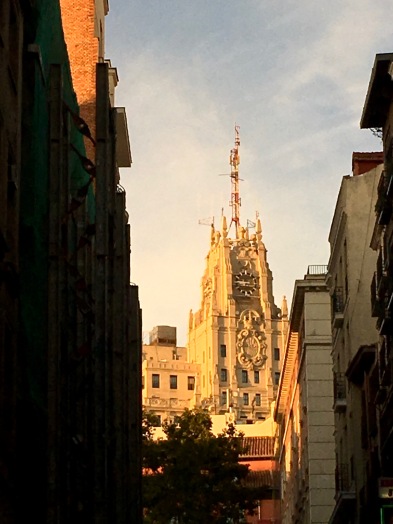
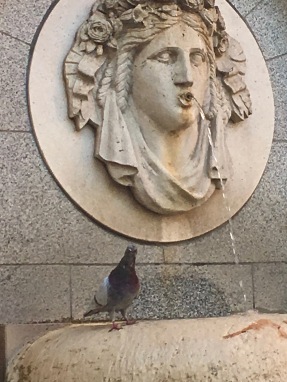
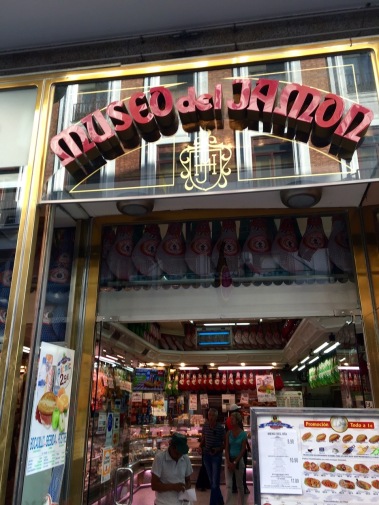
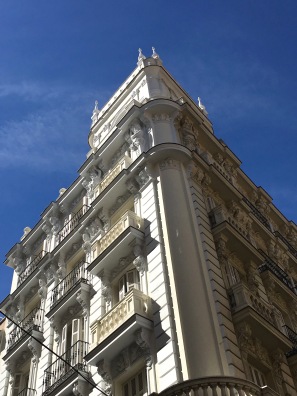

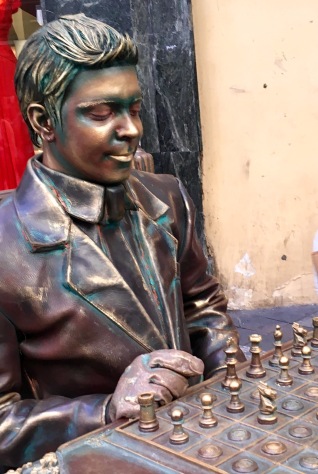
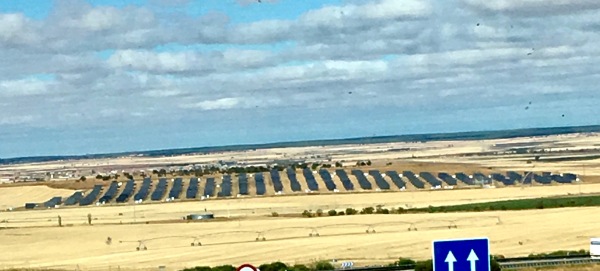
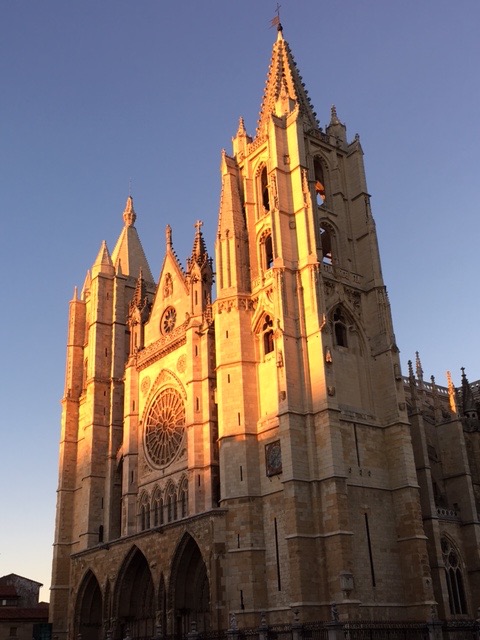
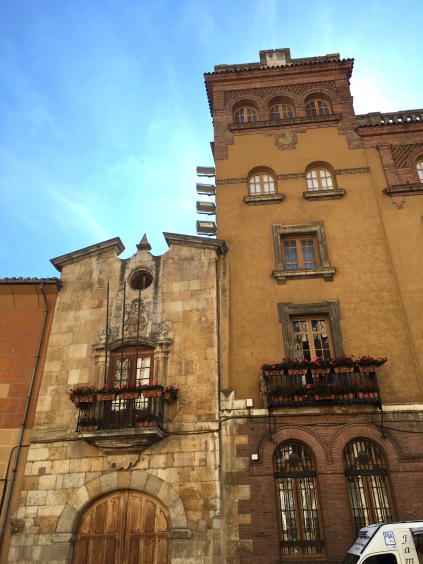

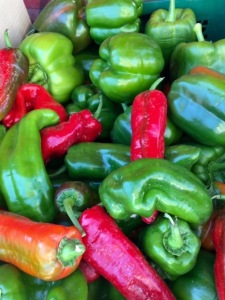
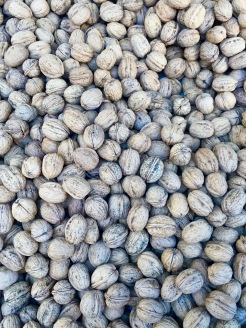



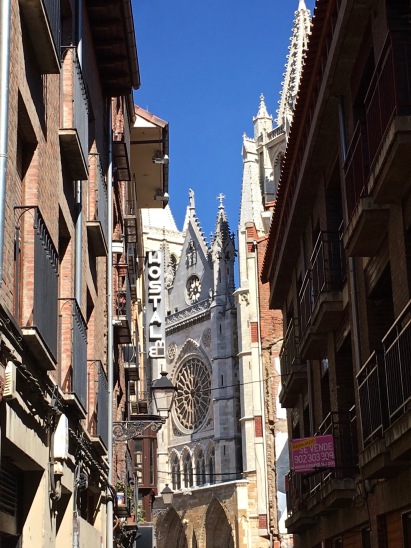
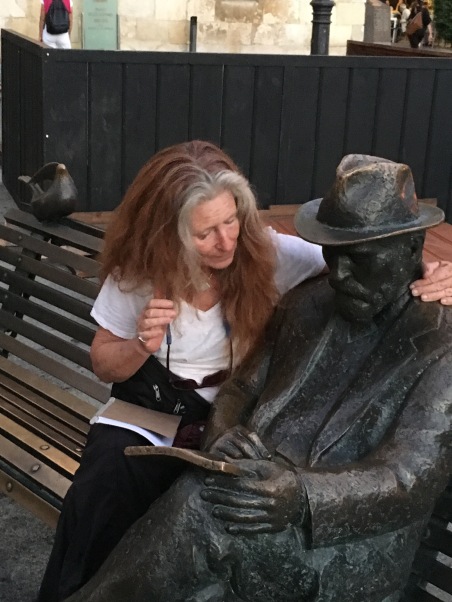
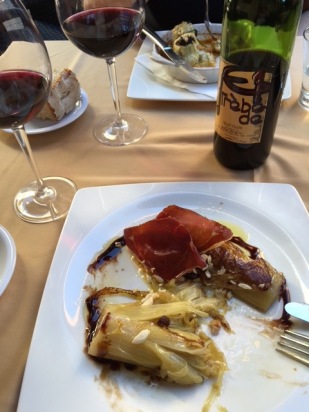

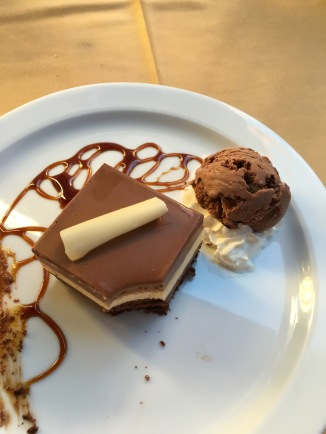

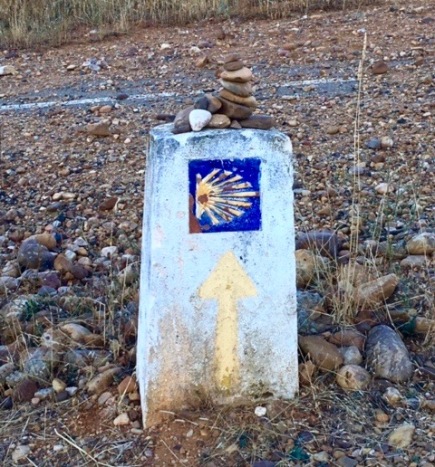

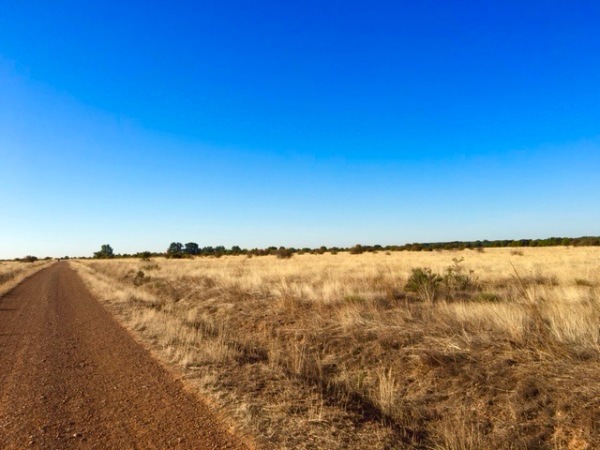
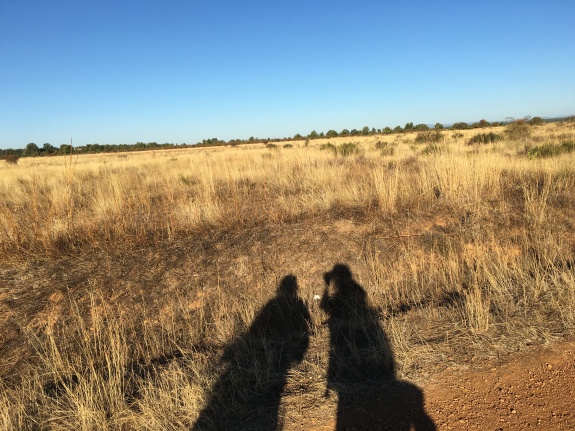

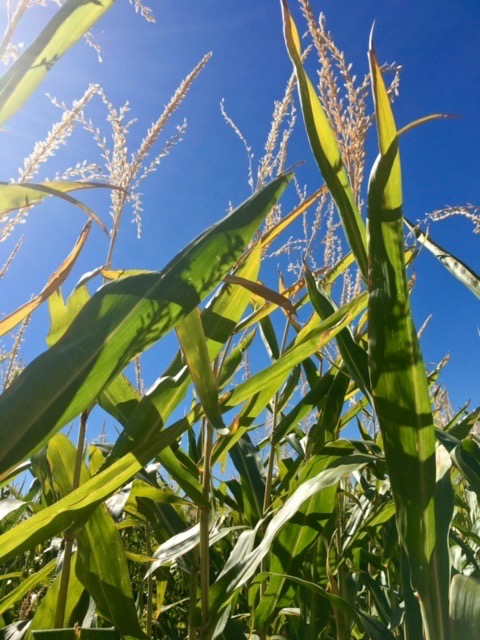
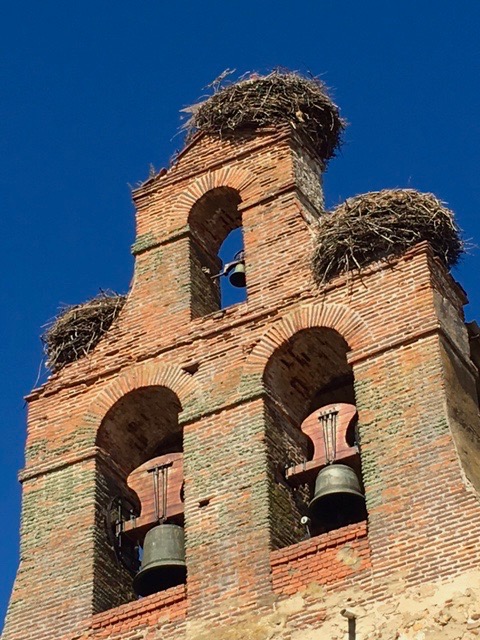
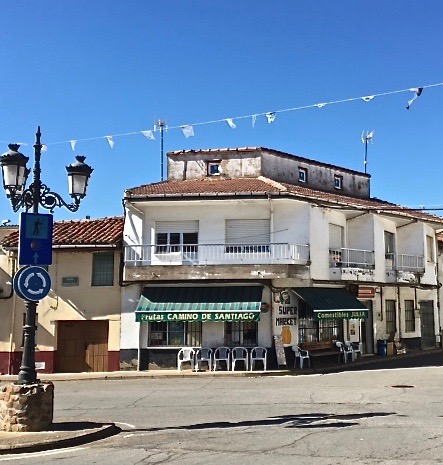
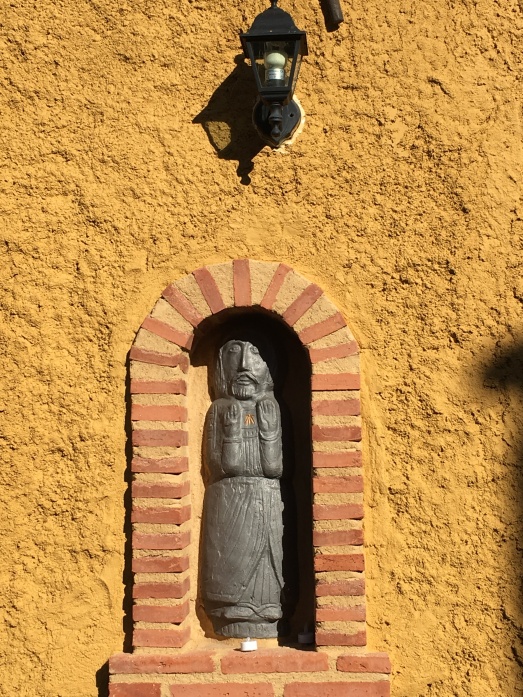
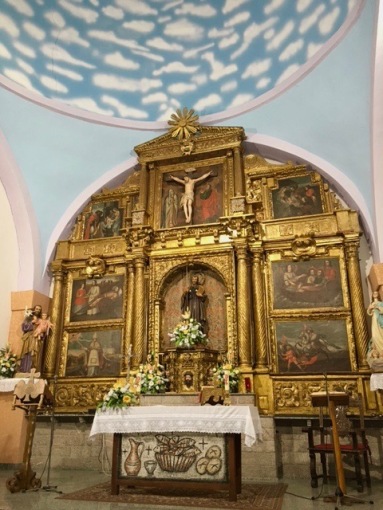
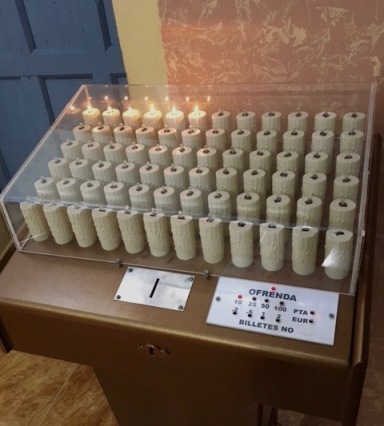
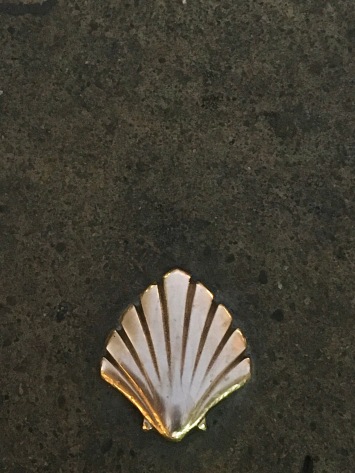
Loved reading about your walk, how adventurous you are Eleanore..you write so well I can almost feel the pain at the end of your every day..looking forward to the next installment..sandra
LikeLike
I just finished reading Musings from Along the Camino and I absolutely loved it. I was there, but this blog brought back things I had already forgotten, and it perfectly captures the mood and feelings of our trip to northern Spain. This is a must read for anyone interested in the Camino de Santiago, and for anyone who loves to travel. The pictures are also wonderful I can’t wait for further installments. Hurry Eleanore!
LikeLiked by 1 person
Reading this was like being there, or perhaps watching like one the birds that accompanied you both on the Way. I would like to experience this myself now….someday.
LikeLike
Love it!!! Can’t wait to read more!
LikeLike
What a trip!! I love reading whatever you write! You have charisma in writting… I look forward to read more! xx
LikeLike